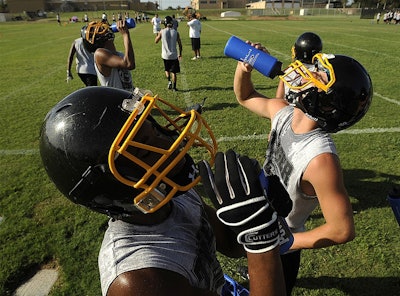Snow may still be on the ground in some parts of the country, but at least two northern states have adopted heat-management policies for high school student-athletes during the past week.
Heat and humidity management is the latest step in the Michigan High School Athletic Association's ongoing focus on health and safety issues, and the association's new model policy - while not setting requirements for member schools - proposes actions based on the heat index and is designed to minimize the risk of heat-related illness during practice and competition. The policy states that temperature and humidity readings should be taken 30 minutes prior to the start of activity and again 60 minutes after it has begun. Additionally, recommendations for hydration and levels of activity are suggested for each of four levels of heat index readings.
Practices should be postponed or moved when the heat index - the degree of felt discomfort derived by combining temperature and humidity measurements - hits between 99 and 104 degrees, and all activity is to be stopped if the heat index rises above 104.
The model policy also includes frequency and length of water breaks, appropriate uniforms based on heat index and mandates on what time of day practices should be conducted and for how long, and it will be mandatory for MHSAA tournaments beginning this fall.
MHSAA executive director John E. "Jack" Roberts says several Michigan high schools already have solid heat management policies in place, but he hopes the adoption of this "best practice" will further raise awareness of the risks of heat-related illness while giving schools - especially those without a protocol - an opportunity to adopt a standardized policy similar to what is in place for other environmental factors such as lightning and tornadoes.
 0313_hydration.jpg
0313_hydration.jpg
Meanwhile, the Pennsylvania Interscholastic Athletic Association will require all high school football programs in the state to undergo a three-day heat-acclimatization process before 2013 practices can begin. Schools will have the option of completing the process the week prior to the official start of practice or spending the initial three days of practice completing the mandatory process. Failure to comply, in the words of PIAA executive director Bob Lombardi, may result in "forfeiture of championship rights."
According to PennLive.com:
During the heat acclimatization process football players are permitted to wear helmets and shoulder pads the first two days. On the third day full protective equipment is permitted.
Contact is not permitted during the first two days days of heat acclimatization, but contact can take place on the third day.
No practice session during the heat acclimatization process can last more than three hours. And it must be followed by a break of at least two hours. And football teams are limited to a maximum of five hours of practice a day regardless of the length of each session.
And each head football coach must come up with a heat acclimatization proposal and submit it to the school principal for approval.
"Since 1995 there have been 41 high school football heat-related deaths nationwide. These deaths may be preventable," Lombardi told PennLive.com. "You can't prevent everything, but from a health and safety [standpoint] we want to make sure we have a heat acclimatization and hydration program in place to ensure our student-athletes are as safe as possible. It's a national trend, and has been gaining steam over the last five years. And we're trying to provide a safe environment for our athletes. That is part of our purpose as a state athletic organization."
Last year, the National Federation of State High School Associations released a position statement encouraging all state associations and member schools to adhere to detailed heat acclimatization guidelines and take a new online course, "A Guide to Heat Acclimatization and Heat Illness Prevention." (The NFHS document is based in part on previous research and recommendations by the National Athletic Trainers' Association and the American Academy of Pediatrics.)
"That National Federation document changes things," Douglas Casa, a leading expert on exertional heat illness and chief operating officer of the University of Connecticut's Korey Stringer Institute, told AB last July. "Now, if a high school is doing nothing about exertional heat illness, it's going to have a problem explaining why it wasn't addressing any of the things the federation recommends."
































